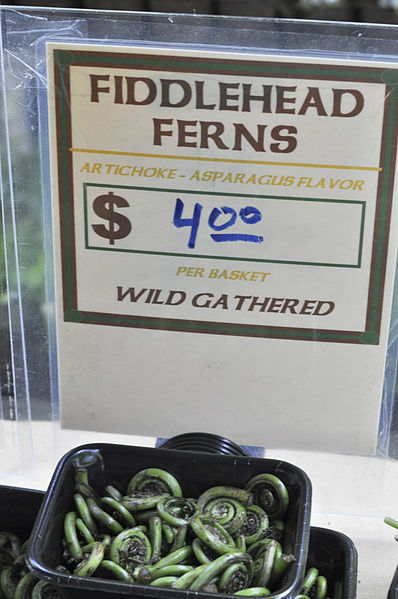 |
| Photo by Tammy |
One of the first wild vegetables you can harvest in the
early spring are ‘fiddleheads’
so named because of their resemblance to the stem of a violin. They are actually the young sprouts of a fern
and taste a lot like asparagus. The fiddlehead unrolls as the young fern matures. Some people know this as a crozier after the curved staff
used by a Shepard or a bishop.
Fiddleheads are eaten as a cooked vegetable by many people.
Before they are eaten they first have to be cooked to remove
a poisonous compound called ‘skikimic acid.”
This is accomplished by cooking them two times. The first cooking is to remove the skikimic
acid that is removed in the cooking process.
Water used in the first cooking should be lightly salted and is
discarded once the cooking is complete.
Starting with fresh lightly salted water finish cooking the fiddleheads
then serve with butter, salt and pepper.
The most popular ferns for plucking fiddleheads from are:
- Bracken, Pteridium aquilinum, found worldwide
- Ostrich
fern, Matteuccia struthiopteris, found in northern regions
worldwide, and the central/eastern part of North
America
- Cinnamon
fern or buckhorn fern, Osmunda cinnamomea, found in the Eastern
parts of North America
- Royal
fern, Osmunda regalis, found worldwide
- Zenmai or flowering
fern, Osmunda japonica, found in East Asia
- Vegetable
fern, Athyrium esculentum, found throughout Asia and Oceania
Fiddleheads are plucked in the early spring by plucking
three fiddleheads from each fern plant.
Fern plants usually have seven fiddleheads per fern plant. By harvesting only three fiddleheads per
plant you will prevent the plant from dying.
These are wild plants and are not farm raised as many of our vegetables
are. Because they are wild sustainable
harvesting methods are important for ferns or any other wild food plant.
Most of the fiddleheads in the Northeast come from the
ostrich fern. The fiddleheads appear in
the early spring (April of May) and should be harvested then. They can be served like asparagus on toast,
or chilled can be used in a salad with onions and vinegar.
“The Center for Disease Control (CDC) has investigated a
number of outbreaks of food-borne illness associated with fiddleheads. The
implicated ferns were eaten either raw or lightly cooked (sautéed, parboiled or
microwaved), which was what caused a food-borne illness outbreak in British
Columbia in 1990. Although a toxin has not been
identified in the fiddleheads of the ostrich fern, the findings of this
investigation suggest that you should cook
fiddleheads thoroughly before eating (boil them for at least 10 minutes).”
To save for eating
later in the season fiddleheads can be frozen by preparing then as you would
for the table. You can do this by
blanching the fiddleheads for two minutes.
Cool and thoroughly drain. Place
the fiddleheads into moisture and vapor proof containers and place them into
your freezer. Recook for 10 minutes
before eating.
References:
U of Maine, Facts
on Fiddleheads, http://www.umext.maine.edu/onlinepubs/htmpubs/4198.htm
Fiddlehead Fern, Wikipedia the free encyclopedia, http://en.wikipedia.org/wiki/Fiddlehead

No comments:
Post a Comment